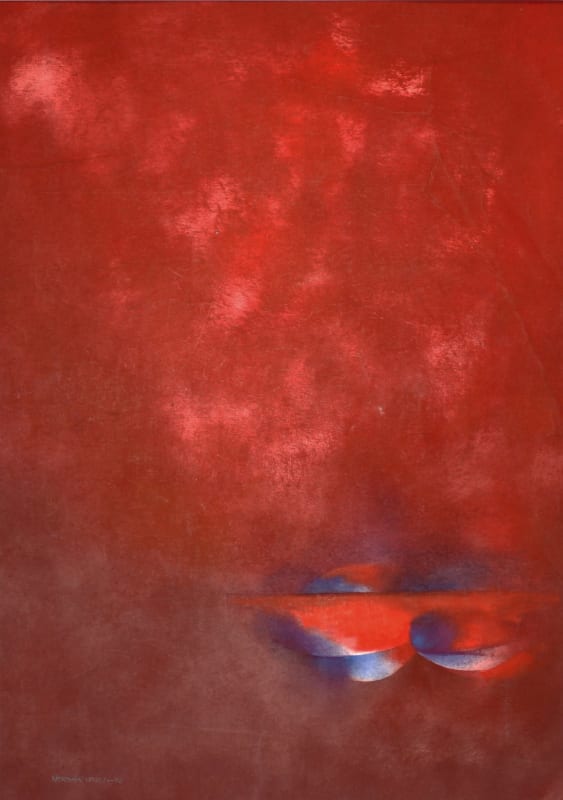NEW YORK, NY November 8 - Bill Hodges Gallery is proud to introduce our current exhibition. "Norman Lewis: Works on Paper," an exhibition featuring significant works on paper by the renowned African American artist, scholar, teacher, and a key figure of the Abstract Expressionist movement.
Born in Harlem, on July 23, 1909, Norman Lewis was a pivotal figure in mid 20th century American art, navigating both the world of abstraction and the political landscape of the civil rights movement. Attending the Teacher's College at Columbia University, he immersed himself in the vibrant artistic and intellectual scene of the time. While at Columbia, he joined the 306 Group, a collective co-founded by Charles Alston that became a vital hub for the exchange of ideas between artists and social activists. In 1935, Lewis and his peers went on to establish the Harlem Artists' Guild, a pivotal organization that championed the role of Black artists in addressing social issues. His work defies easy categorization, reflecting his deep commitment to social justice as well as his innovative approach to formal composition.
In the early 1930s, Lewis' work was primarily figurative, reflecting a social realist style that documented the realities of poverty, police brutality, and injustice in his community.
In contrast to some of the more energetic works in the show, Untitled, 1935 highlights a docile and dignified feminine figure, elegantly seated at a café table. The woman's eyes are closed, her visage, and the glass almost falling from her hand suggest that she may have succumb to intoxication or that the weight of the day has lulled her to sleep. Despite her less than lucid state, she remains poised in a stylish hat and high heels with her legs crossed, and her arm gesturally draped across her leg. Besides the details of the checkerboard floor, round table, chair, glass and bottle, all other special details are obscured inviting the viewer to narrow in on the subject and the story her environment tells.
In works such as Untitled, 1960, Lewis depicts a "tribe" of his iconic "little people" amongst a frenetic landscape. This highly energetic, work curiously contrasts the more stoic, barren large canvas paintings Lewis is most known for. While his canvases often feature a few figures, if any, against a field of color, this work on paper exhibits a collection of figures strewn about a dynamic background. Although the viewer may be tempted to quickly write this work off as a confused, unsensational "mess", on closer inspections one may find the work to be in fact balanced, finding a median point between Lewis' earlier "busier" works and his later atmospheric compositions.
Lewis' artistic contributions were not only visual, but intellectual, as he played a central role in reshaping the narrative of African American artists in a predominantly white art world. His involvement with movements like the Harlem Renaissance and later co-founding of Spiral Group (a group dedicated to supporting Black artists and responding to the Civil Rights Movement through art) alongside Romare Bearden, Charles Alston, and Hale Woodruff, highlighted his dedication to elevating African American art and culture.
Despite being one of the few Black artists within the first generation of Abstract Expressionists, Lewis' contributions were largely overlooked during his lifetime. However, in recent decades, following his death in 1979, his work has begun to garner the recognition it long deserved, with works now residing in the permanent collections of many major institutions, including the Art Institute of Chicago, the Museum of Modern Art in New York, The National Gallery of Art and Smithsonian American Art Museum in Washington, D.C.
Our exhibition features a selection of Lewis' works offering an intimate view into the creative process and vision of one of the 20th century's most important artists. Known for his energetic, gestural abstractions, Lewis' works on paper demonstrate his mastery of line, texture, and form, capturing the same dynamic energy that defined his larger canvases. While Lewis is best known for his paintings, his works on paper reveal a distinct sensitivity to the medium, often experimenting with a variety of subjects and techniques. These works provide insight into his evolving artistic journey, from his early figurative compositions to his later abstractions, and underscore his role in both the Harlem Renaissance and the broader art historical context.
Norman Lewis: Works on Paper will be on view at Bill Hodges Gallery until 25 January 2025. This exhibition is an exceptional opportunity for art enthusiasts, historians, and collectors to engage with the evolution of an artist whose influence continues to resonate across generations. Visitors will experience an intimate grouping of Lewis's experimentation and innovation through his works on paper, which embody the core of his artistic philosophy.


